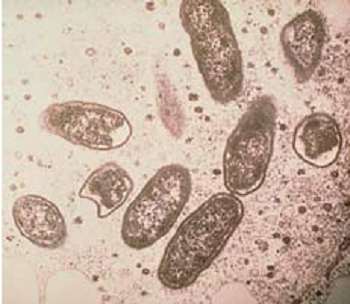Rickettsia rickettsii - Lab diagnosis, Clinical Manifestation/Syndrome
Laboratory Diagnosis of Rickettsia rickettsii
The laboratory diagnosis of Rickettsia rickettsii begins with the collection of samples.
Specimen
Skin biopsy
serum
Culture
The culture of Rickettsia rickettsii can be done by following methods:
Egg culture
animal culture
tissue culture
Direct antigen (Ag) detection
Specific anti-rickettsial antibody labeled with the fluorescent compound in direct Antigen detection used for detection of Rickettsia rickettsii in skin biopsy.

Fig: Rickettsia rickettsii electron microscopy (Source: Wikipedia)
Serodiagnosis
The serodiagnosis Rickettsia rickettsii can be done by following methods:
Indirect Immunofluorescence Assay – detect IgG and IgM
ELISA
DOT assay
Weil-Felix test
Clinical manifestation/syndrome
Rickettsia rickettsii is the causative agent of the Rocky Mountain spotted fever.
The incubation period of 7 days and symptoms includes fever, severe headache, chills, and myalgia. After 2-4 days of onset of fever, a spotted rash appears on wrists, forearms, ankles, palms, and soles.
Other clinical manifestations/syndromes include low platelet count, low sodium level in the blood, and elevated liver enzymes are severe in immunocompromised patients.